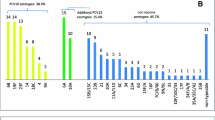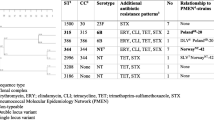Abstract
Background
Pneumococcal urinary antigen test is a valuable tool for diagnosing pneumococcal pneumonia and meningitis in adults. Its use in children is generally not accepted because of nonspecificity at this age. It is frequently positive in asymptomatic nasopharyngeal carriers.
The aim of our study was to assess the age limit from which the test is no longer positive in asymptomatic healthy carriers.
Methods
A total of 197 children aged 36–83 months attending 9 day care centers in Prague were enrolled during February and March 2010. Nasopharyngeal swab specimens were collected from each participant and selectively cultivated. The presence of pneumococcal antigen in urine was detected by BinaxNOW® S. pneumoniae kit.
Results
Streptococcus pneumoniae was cultivated in 53.3 % of healthy children with the highest colonization rate (59.3 %) in children aged 48–59 months. The most frequently colonizing serotypes were: 19F, 23F, 3, 19A, 6B and 4. The presence of pneumococcal antigen in urine decreased with age from 39.0 % in 36–47 months to 17.9 % in 72–83 months old (p = 0.031). The antigen positivity was serotype-dependent and more frequent in nonvaccinated children.
Conclusion
We demonstrated age-dependent linear decrease of pneumococcal antigen excretion into urine in healthy children. The positivity rate of the test in children aged 72–83 months was similar to that referred in healthy adults, irrespective of colonization. To confirm this age limit for use of this test in diagnostics of pneumococcal diseases, further study in school-age children is justified.
Zusammenfassung
Grundlagen
Ein Pneumokokken-Antigen-Urintest ist eine wertvolle Methode für die Diagnostik einer Pneumonie und Meningitis bei Erwachsenen. Die Anwendung der Methode bei Kindern ist üblicherweise nicht akzeptierbar, weil diese im Kinderalter für nicht-spezifisch gehalten wird. Der Test ist oft bei asymptomatischen nasopharyngealen Trägern positiv. Das Ziel unserer Studie war, die Altersgrenze, ab wann der Test in asymptomatischen gesunden Träger negativ ist, festzustellen.
Methodik
Insgesamt 197 Kinder im Alter von 36–83 Monaten, die 9 Tages-Betreuungszentren in Prag besuchten, wurden in Februar und März 2010 in die Studie eingeschlossen. Nasopharyngeale Abstriche wurden von jedem Teilnehmer abgenommen und selektiv kultiviert. Für die Entdeckung von Pneumokokken-Antigen im Urin wurde BinaxNOW® S. pneumoniae verwendet.
Ergebnisse
S. pneumoniae war bei 53,3 % gesunden Kindern kultiviert, die höchste Kolonisationsrate gab es bei Kindern im Alter von 48–59 Monaten. Die am häufigsten kolonisierten Serotypen waren: 19F, 23F, 3, 19A, 6B und 4. Das Vorkommen von einem Pneumokokken-Antigen im Urin sank mit Alter – von 39,0 % in 36–47 Monaten zu 17,9 % in 72–83 Monaten (p = 0,031). Die Antigen-Positivität war vom Serotyp abhängig und fand öfter bei nicht-vakzinierten Kindern statt.
Schlussfolgerung
Wir haben einen altersabhängigen linearen Abfall der Exkretion von Pneumokokken-Antigen in Urin bei gesunden Kindern bestätigt. Die Positivitätsrate des Testes bei Kindern, die 72–83 Monate alt sind, ist der Rate von gesunden Erwachsenen, ohne Zusammenhang mit der Kolonisation, ähnlich. Zur Bestätigung einer Altersgrenze für die Verwendung von diesem Test in der Diagnostik der pneumokokkalen Erkrankungen ist eine weitere Studie mit Kindern im Schulalter nötig.


Similar content being viewed by others
References
Ortqvist A, Hedlund J, Kalin M. Streptococcus pneumoniae: epidemiology, risk factors, and clinical features. Semin Respir Crit Care Med. 2005;26(6):563–74.
Dowell SF, Garman RL, Liu G, Levine OS, Yang YH. Evaluation of BinaxNOW, an assay for the detection of pneumococcal antigen in urine samples. performed among pediatric patients. Clin Infect Dis. 2001;32(5):824–5.
Fine MJ, Orloff JJ, Rihs JD, Vickers RM, Kominos S, Kapoor WN, et al. Evaluation of housestaff physicians’ preparation and interpretation of sputum Gram stains for community-acquired pneumonia. J Gen Intern Med. 1991;6(3):189–98.
Hickey RW, Bowman MJ, Smith GA. Utility of blood cultures in pediatric patients found to have pneumonia in the emergency department. Ann Emerg Med. 1996;27(6):721–5.
Stralin K, Kaltoft MS, Konradsen HB, Olcen P, Holmberg H. Comparison of two urinary antigen tests for establishment of pneumococcal etiology of adult community-acquired pneumonia. J Clin Microbiol. 2004;42(8):3620–5.
Dochez AR, Avery OT. The elaboration of specific soluble substance by Pneumococcus during Growth. J Exp Med. 1917;26(4):477–93.
Farrington M, Rubenstein D. Antigen detection in pneumococcal pneumonia. J Infect. 1991;23(2):109–16.
Jenning HJ, Lugoeski C, Young NM. Structure of the complex polysaccharide C substance from Streptococcus pneumoniae type 1. Biochemistry. 1980;19:4712–9.
Marcos MA, Jimenez de Anta MT, de la Bellacasa JP, Gonzalez J, Martinez E, Garcia E, et al. Rapid urinary antigen test for diagnosis of pneumococcal community-acquired pneumonia in adults. Eur Respir J. 2003;21(2):209–14.
Coonrod JD. Urine as an antigen reservoir for diagnosis of infectious diseases. Am J Med. 1983;75(1B):85–92.
Coonrod JD. Evidence of breakdown of pneumococcal polysaccharides in vivo. Proc Soc Exp Biol Med. 1979;162(2):249–53.
Dominguez J, Gali N, Blanco S, Pedroso P, Prat C, Matas L, et al. Detection of Streptococcus pneumoniae antigen by a rapid immunochromatographic assay in urine samples. Chest. 2001;119(1):243–9.
Yu VLKJ, Plouffe JF, et al. Evaluation of the Binax urinary, Gram stain and sputum culture for Streptococcus pneumoniae in patients with community-acquired pneumonia. In: Program abstracts of the 38th Annual Meeting of the Infectious Disease Society of America (New Orleans); 2000.
Hamer DH, Egas J, Estrella B, MacLeod WB, Griffiths JK, Sempertegui F. Assessment of the Binax NOW Streptococcus pneumoniae urinary antigen test in children with nasopharyngeal pneumococcal carriage. Clin Infect Dis. 2002;34(7):1025–8.
Smith MD, Sheppard CL, Hogan A, Harrison TG, Dance DA, Derrington P, et al. Diagnosis of Streptococcus pneumoniae infections in adults with bacteremia and community-acquired pneumonia: clinical comparison of pneumococcal PCR and urinary antigen detection. J Clin Microbiol. 2009;47(4):1046–9.
Smith MD, Derrington P, Evans R, Creek M, Morris R, Dance DA, et al. Rapid diagnosis of bacteremic pneumococcal infections in adults by using the Binax NOW Streptococcus pneumoniae urinary antigen test: a prospective, controlled clinical evaluation. J Clin Microbiol. 2003;41(7):2810–3.
Stralin K, Holmberg H. Usefulness of the Streptococcus pneumoniae urinary antigen test in the treatment of community-acquired pneumonia. Clin Infect Dis. 2005;41(8):1209–10.
Stralin K. Usefulness of aetiological tests for guiding antibiotic therapy in community-acquired pneumonia. Int J Antimicrob Agents. 2008;31(1):3–11.
Pesola GR. The urinary antigen test for the diagnosis of pneumococcal pneumonia. Chest. 2001;119(1):9–11.
Gray BM, Converse GM 3rd, Dillon HC Jr. Epidemiologic studies of Streptococcus pneumoniae in infants: acquisition, carriage, and infection during the first 24 months of life. J Infect Dis. 1980;142(6):923–33.
Slotved HC, Kaltoft M, Skovsted IC, Kerrn MB, Espersen F. Simple, rapid latex agglutination test for serotyping of pneumococci (Pneumotest-Latex). J Clin Microbiol. 2004;42(6):2518–22.
Sorensen UB. Typing of pneumococci by using 12 pooled antisera. J Clin Microbiol. 1993;31(8):2097–100.
Performance standards for antimicrobial susceptibility testing; 21st informational supplement. 21st ed. Wayne, Pa.: Clinical and Laboratory Standards Institute; 2011.
EUCAST. Breakpoint tables for interpretation of MICs and zone diameters (version 1.3). Volume 2011; 2011.
Garcia-Rodriguez JA, Fresnadillo Martinez MJ. Dynamics of nasopharyngeal colonization by potential respiratory pathogens. J Antimicrob Chemother. 2002;50(Suppl 2):59–73.
Leiberman A, Dagan R, Leibovitz E, Yagupsky P, Fliss DM. The bacteriology of the nasopharynx in childhood. Int J Pediatr Otorhinolaryngol. 1999;49(Suppl 1):151–3.
Zemlickova H, Urbaskova P, Adamkova V, Motlova J, Lebedova V, Prochazka B. Characteristics of Streptococcus pneumoniae, Haemophilus influenzae, Moraxella catarrhalis and Staphylococcus aureus isolated from the nasopharynx of healthy children attending day-care centres in the Czech Republic. Epidemiol Infect. 2006;134(6):1179–87.
Dunais B, Pradier C, Carsenti H, Sabah M, Mancini G, Fontas E, et al. Influence of child care on nasopharyngeal carriage of Streptococcus pneumoniae and Haemophilus influenzae. Pediatr Infect Dis J. 2003;22(7):589–92.
Marchisio P, Claut L, Rognoni A, Esposito S, Passali D, Bellussi L, et al. Differences in nasopharyngeal bacterial flora in children with nonsevere recurrent acute otitis media and chronic otitis media with effusion: implications for management. Pediatr Infect Dis J. 2003;22(3):262–8.
Dominguez J, Blanco S, Rodrigo C, Azuara M, Gali N, Mainou A, et al. Usefulness of urinary antigen detection by an immunochromatographic test for diagnosis of pneumococcal pneumonia in children. J Clin Microbiol. 2003;41(5):2161–63.
Tateda K, Kusano E, Matsumoto T, Kimura K, Uchida K, Nakata K, et al. Semi-quantitative analysis of Streptococcus pneumoniae urinary antigen: kinetics of antigen titers and severity of diseases. Scand J Infect Dis. 2006;38(3):166–71.
Sa-Leao R, Nunes S, Brito-Avo A, Alves CR, Carrico JA, Saldanha J, et al. High rates of transmission of and colonization by Streptococcus pneumoniae and Haemophilus influenzae within a day care center revealed in a longitudinal study. J Clin Microbiol. 2008;46(1):225–34.
Conflict of interest
This study was kindly supported by Medial Ltd. by providing the kits for detection of pneumococcal antigen in urine. The authors did not receive any funding or financial assistance from the aforementioned company, neither was the sponsor involved in the design of the study, collection, analysis, interpretation of data, as well as in compilation or in decision to submit the manuscript. The study was partially supported by research grant A/CZ0046/2/0007 from Iceland, Liechtenstein and Norway via the EEA financial mechanism and by research grant IGA 9643–4 from the Internal Grant Agency, Czech Ministry of Health.
Author information
Authors and Affiliations
Corresponding author
Rights and permissions
About this article
Cite this article
Vančíková, Z., Trojánek, M., Žemličková, H. et al. Pneumococcal urinary antigen positivity in healthy colonized children: is it age dependent?. Wien Klin Wochenschr 125, 495–500 (2013). https://doi.org/10.1007/s00508-013-0405-4
Received:
Accepted:
Published:
Issue Date:
DOI: https://doi.org/10.1007/s00508-013-0405-4




